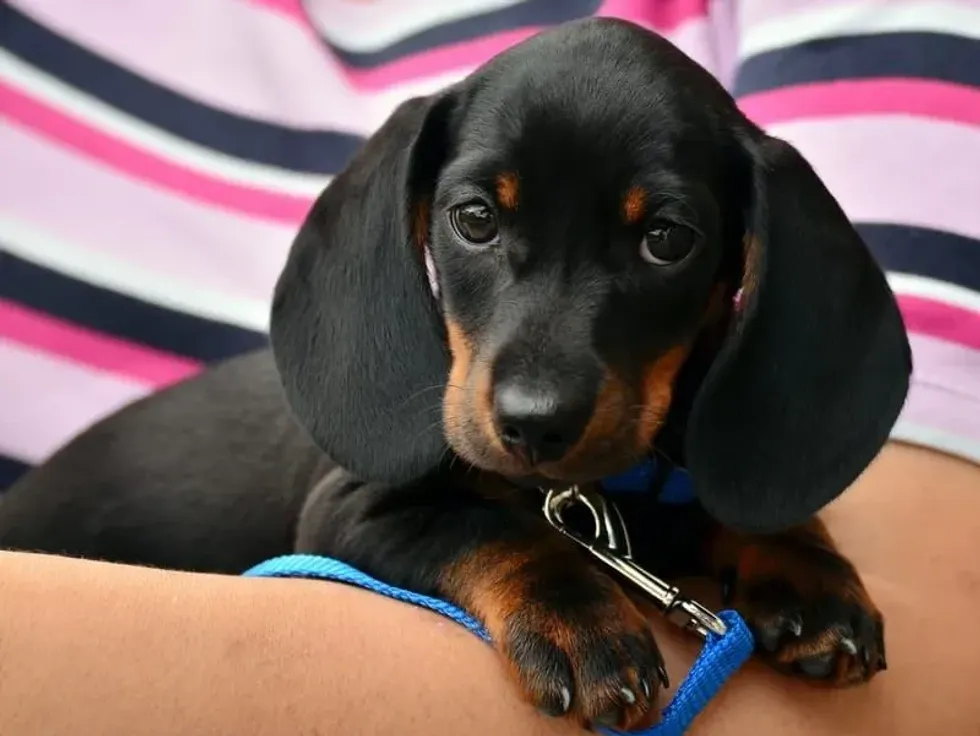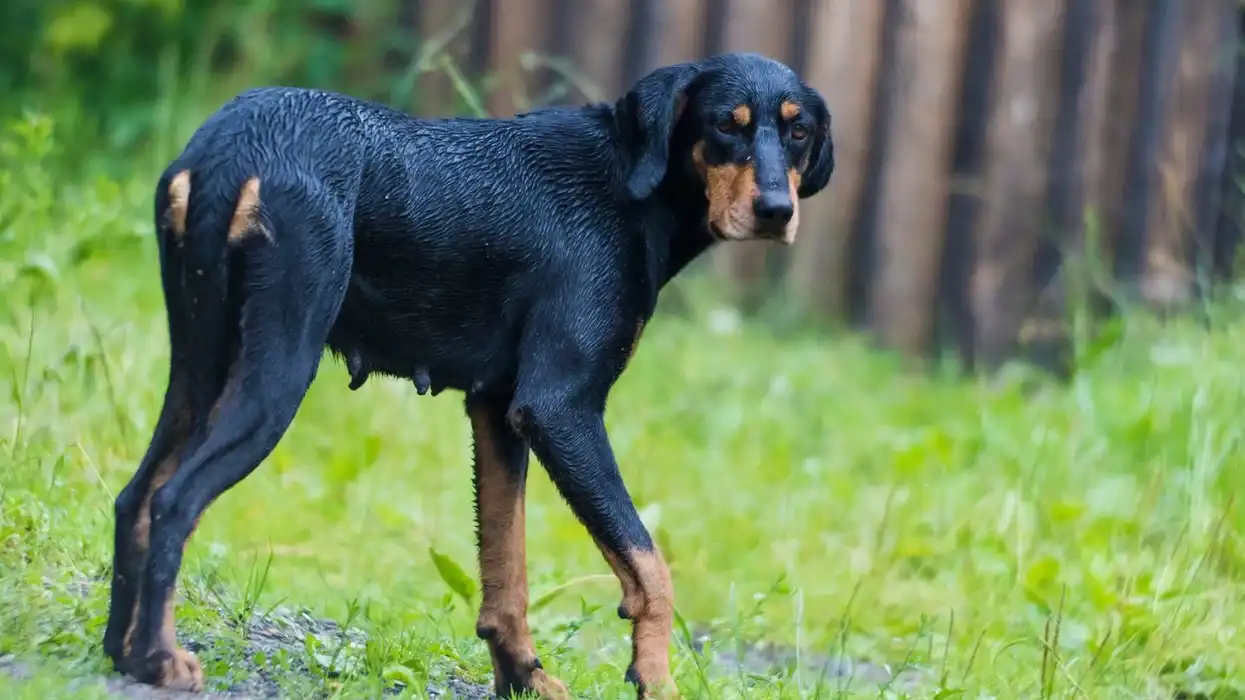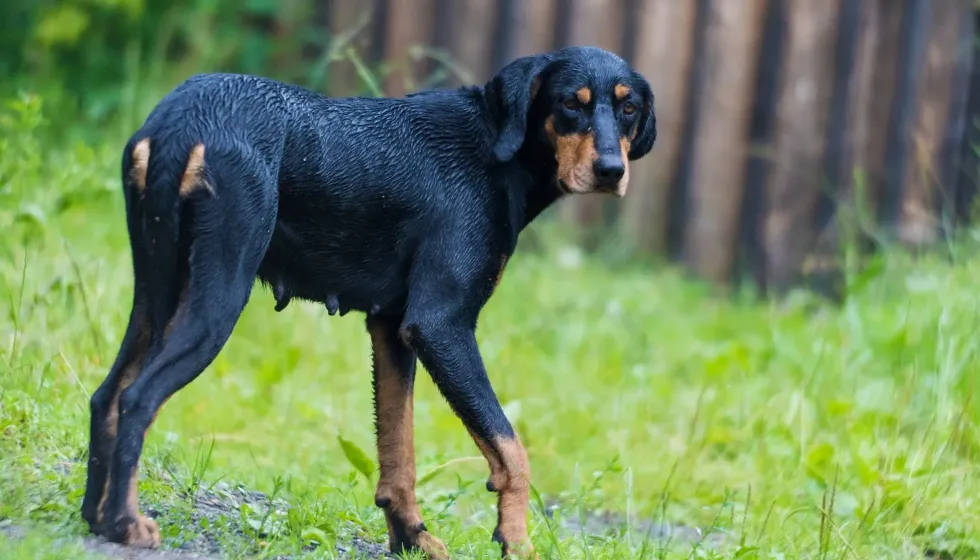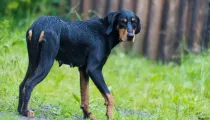Fun Transylvanian Hound Facts For Kids

The Transylvanian hound is a medium-sized breed that was accepted by the foundation stock service in February 2015. The scientific name of this hunting dog is Canis lupus familiaris, which has two sub-breeds: long-legged Transylvanian and short-legged Transylvanian.
They have different names, such as scent hound, Hungarian Hound, and Erdélyi Kopó. The Transylvanian hound is a breed that originated from Hungary and is found all over the world.
Many articles and reports show that Transylvanian hound was also used as a hunting dog, and it usually hunts both small and large animals. As these dogs are hunting dogs, they are naturally more energetic and active.
The Transylvanian hound size is similar to any medium-size dog with a weight of around 55-77 lb (25-35 kg) and is 18-26 in (46-66 cm) tall. They have a life span of about 10-12 years. The hound has no significant threats but can sometimes face issues related to body postures such as hip dysplasia and elbow dysplasia.
They are one of the medium shedding dogs with a black and tan coat and hairy skin. The Transylvanian hound can be dangerous for those who are highly allergic to dogs. They require daily grooming and a set training regime. The training should include any sports activity, daily walk, running to keep them energetic and in shape.
If you liked this, then you must also give a read to flat-coated retriever and Chihuahua.
Transylvanian Hound Interesting Facts
What type of animal is a Transylvanian Hound?
Transylvanian hound is a medium-sized dog from the hound group family.
What class of animal does a Transylvanian Hound belong to?
Transylvanian hound is a dog breed from the mammal class. They are Hungarian hound dogs that originated from Hungary and Romania.
How many Transylvanian Hounds are there in the world?
An official study regarding the population of this dog breed has not been conducted. The pedigreed Transylvanian hound population in Hungary is about 600-800, and there are approximately the same amount in other countries like Romania, the U.S., and Germany.
Where does a Transylvanian Hound live?
Transylvanian hound is one of the Hungarian breeds known as Erdélyi Kopó, and it is famously bred for hunting small and large animals. They are not so aggressive and live in the house with human beings as their pet. It requires proper training such as an active game or sports to maintain their wellbeing as a pet.
What is a Transylvanian Hound's habitat?
Transylvanian hound is a dog breed that was accepted in the foundation stock service in February 2015. This breed, also known as the Transylvanian scent dog, has two sub-breeds: longlegged and shortlegged from Hungary and Romania.
The Transylvanian hound is a dog breed that was historically used as a hunting dog as they had great hunting instincts. Along with hunting instincts, they are also considered to be good family pets. They eat hand-made dry food full of protein, including brown rice, beef, eggs, green leafy vegetable, blueberries, apples, etc.
As they are one of the hunting breeds, they are pretty active and require proper training and exercise daily, which is very beneficial for their health and maintaining their body. They have a balanced temperament making them great around children while also being the best companion for adult family members.
They also face health issues such as hip dysplasia and elbow dysplasia.
Who do Transylvanian Hounds live with?
The Transylvanian hound is a Hungarian dog that usually lives with people in their homes as their family pets. They are used as hunting dogs by most owners. This breed is a loyal dog with a low temperament that prefers living with adults and children alike.
How long does a Transylvanian Hound live?
The life span of the Transylvanian hound from the hound group is around 10-12 years. They are dogs living through the middle ages that require lots of exercise and training to keep themselves fit and fine.
Hounds face many types of health issues like elbow dysplasia and hip dysplasia, which may affect dog postures and, in worst cases, their life span. Regular sporting activity can help them in being more active, healthy, and energetic.
How do they reproduce?
There is no specified information given regarding the reproduction process of the Transylvanian Hound dog. The average litter size of hounds is four to six puppies.
The dog's reproduction generally occurs in four phases. The heat cycle of females lasts about 18 to 21 days starts from the first stage called proestrus.
In this stage, the female may attract males but may not be ready to breed. The next stage is estrus, the vulva becomes soft, which lasts for three to four days, and the female will be receptive to the male.
After the third phase is diestrus, about 60-90 days until they give birth, the female will not mate. And then, they finally enter into the anestrus, which is a period between the last cycle and the beginning of proestrus.
What is their conservation status?
According to IUCN, they are listed as Endangered. During the 20th century, they were nearly extinct. This was because of World War I due to which forested areas shrank and the marshes got drained.
This launched hunting with hounds back into Transylvania. In 1947, a few organizations declared this breed to be dangerous to the game, and there were mass-extermination efforts that nearly completely killed this breed. However, they slowly recovered through the later years.
Their population was at its peak during the middle ages. The Transylvanian hound is a Hungarian breed from the hound group. A hound is a healthy breed with lesser threats globally and requires regular exercise and sporting activities for being fit and fine.
Transylvanian Hound Fun Facts
What do Transylvanian Hounds look like?

The Transylvanian hound size is a medium-sized dog, and it was entered into foundation stock service during the program of 2015. It has a black and tan dense coat with tan spots.
The skin is fully covered with hair, but they do not shed as much as other large dogs. Their coat has tan markings and a little furry pattern. Hounds require proper and regular grooming and training, and comparatively, they have a low temperament.
The hound dog originated from Hungary, being 18-26 in (46-66 cm) tall with a weight of around 55 to 77 lb (25-35 kg). Transylvanian hound dogs have two sub-breeds that are long-legged and short-legged. They are energetic dogs that unfortunately face some common health problems, such as hip dysplasia and elbow dysplasia, and so they require special attention.
How cute are they?
Transylvanian Hounds, like most dogs, are cute, especially when they are little pups. Transylvanian Hound is a medium-sized breed with a soft, cozy, and hairy coat on its body.
Hounds are hunting species with not-so-aggressive personalities and are loyal and friendly toward human beings. They are a very adorable breed that is loving and well-mannered. They are very protective and courageous.
How do they communicate?
The Transylvanian hound dog breed communicates like most dogs. A Transylvanian hound's bark indicates an intruder in their property or to get their owner's attention. They have comparatively high-pitched loud ringing bark for communicating.
They may display certain signs and body language to convey their feelings to their owner on rare occasions. They may also bark excessively when they're bored. So, keep an eye out for them.
How big is a Transylvanian Hound?
The Transylvanian hound is a medium-sized breed of about 18-26 in (46-66 cm). They are three to four times bigger than the bulldog's breed. Bulldogs are usually 12-16 in (31-40 cm) tall.
How fast can a Transylvanian Hound run?
The Transylvanian hound's running speed has not been officially recorded, but certain owners claim they can run up to 25 mph (40 kph). The Transylvanian hound dog is an active breed that is bred to hunt small to medium-sized mammals.
The Transylvanian hound requires daily exercise regimes and training like any sports or game to maintain their energy.
As these dogs are used as hunters, they are expected to be more active and energetic than others. The owners should constantly keep an eye on their health and diet as they face several health conditions.
How much does a Transylvanian hound weigh?
A Transylvanian hound's average weight is around 55-77 lb (25-35 kg). Their weight generally depends on their diet, how much they eat per day along with the daily exercises and activities. The diet of the hound breed may change according to their growth and age.
What are the male and female names of the species?
Like all dogs, the male is referred to as a dog, and the female is referred to as bitch.
What would you call a baby Transylvanian Hound?
Transylvanian hound babies are called puppies. Transylvanian puppies are a perfect companion for children, and their calm nature makes them perfect even when they grow up. They are great family pets.
What do they eat?
The Transylvanian hound usually eats dry dog food full of proteins. These dogs require a different diet at different stages of their life. Therefore it is best recommended to consult your veterinarian to know the best diet for your Transylvanian hound.
Are they hypoallergenic?
The Transylvanian hound, being hypoallergenic, is not an issue with a regular owner, but this breed does shed a fair amount. It may not be comparable to certain large dogs, but people suffering from allergies should avoid being in the same room as this dog to avoid allergy-related health issues.
Would they make a good pet?
The Transylvanian hound is one of the best Hungarian family pet breeds. This breed is also used for hunting by many people in different areas.
A Transylvanian hound's healthy weight is about 55-77 lb (25-35 kg) which means they are medium-sized, active dogs with low temperament. They are good-natured, loyal dogs from the hound group, bred specifically for hunting that prefer living with humans as their pet. Hounds love children and especially like to spend time with adult ones.
The Transylvanian hound requires regular grooming and training. The grooming procedure is very simple, including occasionally brushing with a bristle brush and bathe twice or thrice a week. The owner should follow their daily exercise routines, including any sports or game to maintain energy and health.
Did you know...
There are two types of breeds of the hound, one with short legs and the other with comparatively larger legs. So, the Transylvanian hound's prices may differ according to the breed and area. The average Transylvanian Hound price is about $600-$800.
What dogs were originally bred to create the Transylvanian Hound?
They were bred specifically to hunt. The Transylvanian hound dog breed originated around the 9th century when the Asian hound was brought to Hungary by Hungarian Magyar tribes.
They were then cross-bred with the Celtic hound, resulting in the two varieties of the Transylvanian hound – short and long-legged. The long-legged breed was used for hunting bears, wild boars, and buffaloes, while the short-legged breed was used for hunting smaller creatures like hare and fox.
How rare is the Transylvanian Hound?
The Transylvanian Hound dog breeds are still incredibly rare. Different organizations gave many reports and articles, and researchers show that the short-legged variety of Transylvanian Hound is extinct. In 1968, the wildlife maintenance group took many active steps to increase the population by different methods.
Here at Kidadl, we have carefully created lots of interesting family-friendly animal facts for everyone to discover! Learn more about some other mammals from our Tibetan mastiff facts and Pyredoodle facts pages.
You can even occupy yourself at home by coloring in one of our free printable Transylvanian Hound coloring pages.
We Want Your Photos!
More for You
See All
Bachelor of Commerce specializing in Accounting and Finance, Master of Business Administration

Divya RaghavBachelor of Commerce specializing in Accounting and Finance, Master of Business Administration
With a diverse range of experience in finance, administration, and operations, Divya is a diligent worker known for her attention to detail. Born and raised in Bangalore, she completed her Bachelor's in Commerce from Christ University and is now pursuing an MBA at Narsee Monjee Institute of Management Studies, Bangalore. Along with her professional pursuits, Divya has a passion for baking, dancing, and writing content. She is also an avid animal lover who dedicates her time to volunteering for animal welfare causes.
Bachelor of Commerce specializing in Marketing and HR

Pradhanya RaoBachelor of Commerce specializing in Marketing and HR
With a Bachelor’s degree in Commerce from Christ University, Bangalore, Pradhanya's passion for the English language and literature led her to explore the field of content writing, where she has gained extensive experience in writing, reviewing, editing, and fact-checking. She has also earned certifications in Google Ads Search, Google Ads Display, and Social Media Marketing, showcasing her proficiency in digital marketing.
Disclaimer
1) Kidadl is independent and to make our service free to you the reader we are supported by advertising. We hope you love our recommendations for products and services! What we suggest is selected independently by the Kidadl team. If you purchase using the Buy Now button we may earn a small commission. This does not influence our choices. Prices are correct and items are available at the time the article was published but we cannot guarantee that on the time of reading. Please note that Kidadl is a participant in the Amazon Services LLC Associates Program, an affiliate advertising program designed to provide a means for sites to earn advertising fees by advertising and linking to Amazon. We also link to other websites, but are not responsible for their content.
2) At Kidadl, we strive to recommend the very best activities and events. We will always aim to give you accurate information at the date of publication - however, information does change, so it’s important you do your own research, double-check and make the decision that is right for your family. We recognise that not all activities and ideas are appropriate for all children and families or in all circumstances. Our recommended activities are based on age but these are a guide. We recommend that these ideas are used as inspiration, that ideas are undertaken with appropriate adult supervision, and that each adult uses their own discretion and knowledge of their children to consider the safety and suitability. Kidadl cannot accept liability for the execution of these ideas, and parental supervision is advised at all times, as safety is paramount. Anyone using the information provided by Kidadl does so at their own risk and we can not accept liability if things go wrong.
3) Because we are an educational resource, we have quotes and facts about a range of historical and modern figures. We do not endorse the actions of or rhetoric of all the people included in these collections, but we think they are important for growing minds to learn about under the guidance of parents or guardians.







